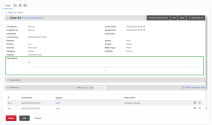When you process an interaction in 8x8 Contact Center with an existing customer, you create or edit a case record of the interaction either during or after the interaction. You can create, edit, and save a case record, which the CRM pulls out during the next interaction with the same customer, enabling you to process the case efficiently. Create follow-up records to handle subsequent interactions with the customer regarding the same case. When the customer needs information, you may respond by emailing the case information to them.
The Cases tab allows you to:
- Create a case record.
- Edit an existing case record.
- Create a follow-up record.
- Send case information notifications.
Best practice: Edit an existing case record if you wish to re-word a case record or change the case attributes such as Status, Priority, Severity, etc. Create a follow-up record for each subsequent interaction of the same case.
The following describes the use of the default customer fields. Depending on how your contact center administrator has configured your Local CRM, the customer creation tool may display additional customer fields. You can notify the customer while creating a case.
To create a case record:
- Go to the customer for whom you are creating a case, and click New Case.
OR
Go to the Cases tab and click New Case.
8x8 Agent Workspace The brand new interface for 8x8 Contact Center agents to receive and process customer interactions. displays the Create New Case page.
The brand new interface for 8x8 Contact Center agents to receive and process customer interactions. displays the Create New Case page. - Select a Customer to associate with the case.
- Change the Status to Open to assign the case to an agent.
- Click Notify if you want to send the customer a case notification or email.
- Select the From address. It can be an agent's or group's email address. Email addresses can have up to 254 characters.
- Select the To address from the list of recipients, such as the customer, if not populated automatically. Select Cc and Bcc recipients if needed.
Note: Based on the configuration of your contact center, the To email addresses may populate automatically, eliminating the need to manually enter the information. You still need to add the Cc and Bcc addresses either from the available list of recipients or manually.
- For Subject and Description, enter the subject of your email and your message regarding the case.
Note: If HTML support is enabled, you can create content in the Description field using the CRM rich text editor. For details on using the CRM rich text editor, see Understand your rich text editor.
- Click
 to add an image. Copy and paste the URL link of the page or image you would like to insert, and enter a descriptive name for the image in the Alternative Text box.
to add an image. Copy and paste the URL link of the page or image you would like to insert, and enter a descriptive name for the image in the Alternative Text box.
Alternatively, you can drag and drop the images or paste them from your clipboard quickly. When you embed a high resolution image in your case, a follow-up, or FAQ, they are compressed automatically for faster processing and for saving bandwidth. If needed, open the Image Properties dialog box from the right-click menu to adjust the image size. The maximum size allowed for image attachments is 20 MB. With drag and drop, you can add images up to 10 MB.Known issue: Copying (Ctrl-C) and pasting (Ctrl-V) images is currently not supported on Internet Explorer 11. You can drag and drop the images.
- Select the Signature for the email message.
Note: You must set the right values for the Default From and Default Signature fields in your profile to automatically populate the From and Signature fields in the Notification and Details tabs.
You can insert FAQs using shortcuts, or by browsing through the FAQ knowledge base. Shortcuts link to the FAQs. For details, see Insert FAQ into email responses.
- To insert an FAQ shortcut, enter the shortcut in the FAQ field and click Insert.
- Click Browse to browse through the FAQ knowledge base, and insert the desired FAQ responses either as full text or links.
- Attach files by browsing or by dragging files from the local file system.
- Click Save as Draft to save a draft of an incomplete case record.
- Click Save to save a completed case record. You can access and edit the case record later.
- Click Send to mail the case record. If the To and From addresses populate automatically, the mail is sent, successfully creating a case record.
Note: Based on the configuration of your contact center, the To and From email addresses may populate automatically, eliminating the need to manually enter the information.
If your contact center configuration does not allow automatic populating, enter the addresses manually.
Edit or delete case records
After you create and save a case record, you can edit the information or delete a case record provided that you have the permissions to delete and edit. Contact your 8x8 Contact Center administrator to learn about your permissions.
To edit or delete a case record:
- Click the Cases tab. A list of cases appears.
- Click one of the action items available to view, edit, or delete the case record.
OR
Select and open a case from the list by clicking the case number. Click Edit or Delete at the bottom of the page.
View case records
When you open a case, you are able to view details, attachments, follow-ups, and history.
Note: You can configure the order of columns in the result page to arrange them in a particular order. To change the order, select and drag the column to the desired location.
- Case details: Includes information such as the case ID, customer name, account number, status, the agent who created the case, and case description. To view the entire description, click
 to expand the comment pane.
to expand the comment pane.
If a case is created as a result of an incoming email through the email channel, you are able to see the To, Cc, and Bcc fields in the details. - Attachment: Lists all attachments associated with a case and its follow-up records. You can either sort the attachments by name or date, or filter them by the case or follow-up attachments.
 To view and open case attachments:
To view and open case attachments:When downloading CRM attachments, based on the privileges granted to you, you either have the ability to open and save the CRM attachments from emails by clicking the attachments, or are restricted to just saving them locally before opening them. With this restriction, you can exercise caution before opening an attachment, and look out for insecure attachments.
- In 8x8 Agent
 Agents use the Agent Console to view and manage customer interactions. Virtual Contact Center supports Regular agents and Supervisor agents. Workspace, go to the Cases tab and open a case.
Agents use the Agent Console to view and manage customer interactions. Virtual Contact Center supports Regular agents and Supervisor agents. Workspace, go to the Cases tab and open a case. - Open Attachment.

- Click All to view all attachments associated with the case and its follow-ups.
- Click From case to view only the attachments associated with a case.
- Click From follow-ups to view only the attachments associated with the case follow-ups.
- Click the desired attachment to download the file.
- In 8x8 Agent
- Follow-up: Lists the case follow-ups. A case may have multiple follow-ups before it is resolved. Each communication regarding the case from its creation until it is closed may be recorded as individual follow-up instances.
- History: Includes the history of changes made to the case.

